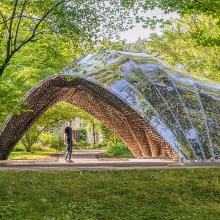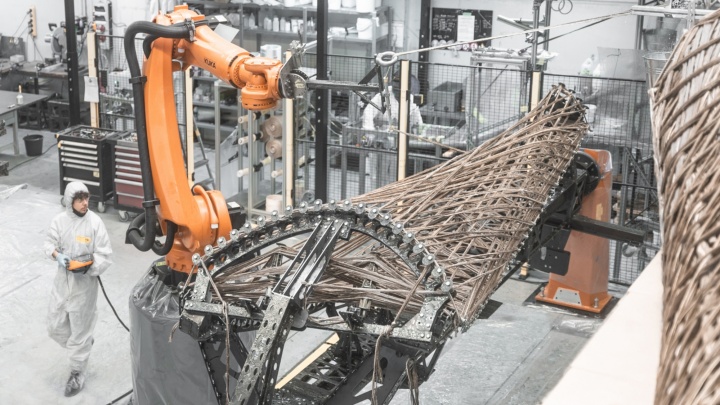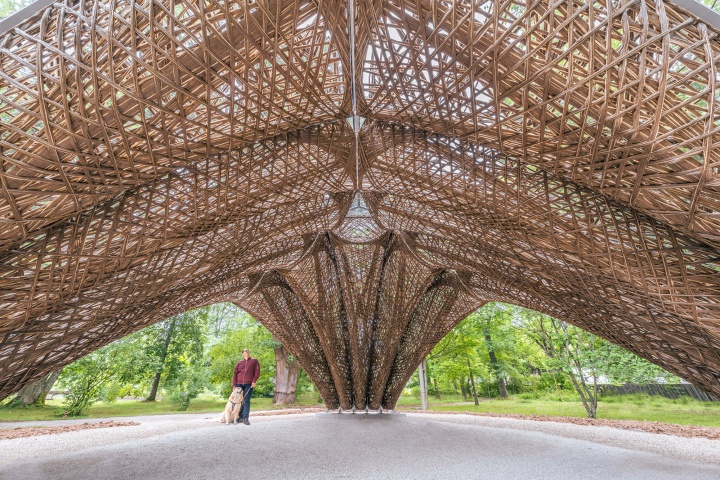The building industry is currently facing the challenge of consuming fewer resources and is thus moving towards sustainable development. This requires new resource-efficient approaches in architecture with regard to the use of renewable materials. In a joint project, researchers from the Universities of Freiburg and Stuttgart together with master’s students from the University of Stuttgart have designed a lightweight pavilion. With this "livMatS Pavilion" - named after the Freiburg Cluster of Excellence “Living, Adaptive and Energy-autonomous Materials Systems” (livMatS) - in the Botanical Garden of the University of Freiburg, the team presents a model for a sustainable, resource-efficient alternative to conventional construction methods.
The pavilion illustrates how a combination of natural materials with advanced digital technologies enables a unique, bio-inspired architecture. The pavilion's supporting structure is made of robotically wound flax fibre, a naturally renewable and biodegradable material.
Efficient lightweight construction with natural fibre materials
Unlike glass or carbon fibres and many other natural fibres, flax fibres are regionally available and grow in annual crop cycles. They are entirely renewable, biodegradable, and therefore provide an excellent basis for the development of innovative resource-saving alternatives in the construction industry. They offer the potential, especially in combination with efficient bioinspired lightweight design, to significantly reduce the environmental footprint of buildings. For these reasons, the load-bearing elements of the "livMatS Pavilion" are made of flax fibres.
Integrative computational design and robotic fabrication
"Fibre composites exhibit outstanding strength-to-weight ratio," explains Prof. Dr.-Ing. Jan Knippers, director of the Institute of Building Structures and Structural Design (ITKE) and co-spokesperson of the Cluster of Excellence “Integrative Computational Design and Construction for Architecture” (IntCDC) at the University of Stuttgart. "This feature provides an excellent basis for the development of innovative, material-efficient lightweight structures." While research to this day has focused on synthetically produced fibre composites, such as glass and carbon fibres, the "livMatS Pavilion" extends the material system to include the application of natural fibres.
"In terms of computational design, robotic fabrication workflows and machine control, natural fibres and their biological variability presented new challenges for us researchers" says Prof. Achim Menges, director of the Institute for Computational Design and Construction (ICD) and spokesperson of the Cluster of Excellence IntCDC at the University of Stuttgart. The processes were originally developed for synthetic, homogeneous materials and now had to be adapted to the material properties of flax fibres. The adaptation of the integrative computational design model enabled the incorporation of these heterogeneous material properties into the design and planning of the individual components as well as the overall structure.
Bioinspiration: Nature as a model
The researchers were guided by nature in the development of the pavilion. The “livMatS Pavilion” was inspired by the saguaro cactus (Carnegia gigantea) and the prickly pear cactus (Opuntia sp.), which are characterized by their special wood structure. The saguaro cactus has a cylindrical wooden core that is hollow inside and thus particularly light. It consists of a net-like structure, which gives the wood additional stability. “This structure is formed as a result of the intergrowth of its individual wood elements”, says Prof. Dr. Thomas Speck, Director of the Botanic Garden Freiburg and member of the spokesperson team of the Cluster of Excellence Living, Adaptive and Energy-autonomous Materials Systems (livMatS) at the University of Freiburg. “The tissue of the flattened side shoots of the prickly pear cactus is also interwoven with net-like wood fibre bundles, which are arranged in layers and interconnected. As a result, the tissue of the prickly pear cactus has a particularly high load-bearing capacity.” The scientists abstracted the network structures of the biological model, and implemented them in the “livMatS Pavilion” by winding, the "coreless winding" of the natural flax fibres. Through this abstraction – plants have no winding or braiding processes – the researchers were able to transfer the mechanical properties of the cross-linked fibre structures to the lightweight structural elements of the “livMatS Pavilion”.
Future use
In the future, the pavilion in the Botanical Garden of the University of Freiburg will serve as an outdoor lecture room for of the Cluster of Excellence livMatS to vividly communicate the research of the Cluster. Researchers will present their work to the public there, for example, in guided tours or workshops. The Cluster of Excellence livMatS conducts research on life-like material systems inspired by nature. The material systems will be purely technical objects, so they can be produced through synthetic methods.
“By its very nature, the pavilion offers points of contact to highlight similarities and differences between biological and technical materials systems and to show the possibilities that bioinspiration offers, for example in architecture but also in other areas of technology," says Prof. Dr. Jürgen Rühe from the Institute of Microsystems Engineering at the University of Freiburg and member of the livMatS Cluster of Excellence’s team of spokespersons.
Cooperation and long-standing collaboration
The pavilion stems from the successful collaboration of an interdisciplinary team of architects and engineers from the ITECH master`s programme at the Cluster of Excellence “Integrative Computational Design and Construction for Architecture (IntCDC)” at the University of Stuttgart and biologists from the Cluster of Excellence “Living, Adaptive and Energy-autonomous Material Systems (livMatS)” at the University of Freiburg.
The project incorporates long-standing research on the topic of computational design and construction with fiber composite structures of the Institutes of Computational Design and Construction (ICD) and Structural Buildings and Structural Design (ITKE) at the University of Stuttgart. An interdisciplinary team of scientists from both institutes in collaboration with students from the master’s program "Integrative Technologies and Architectural Design Research" (ITECH) further developed the research on computational design, robotic fabrication and the new fibre material system. The project continues a series of successful experimental and highly innovative building demonstrators designed and realized by institutes ICD and ITKE. It further strengthens the already successful collaboration between the Cluster of Excellence livMatS at the University of Freiburg and the Cluster of Excellence IntCDC at the University of Stuttgart. IntCDC aims to rethink design and construction through digital technologies to address the ecological, economic, and sociocultural challenges the built environment is facing. The vision of livMatS is to combine nature and technology to develop cutting-edge materials systems and environmental and energy technologies.
Construction details
The load-bearing structure of the pavilion consists of 15 flax fibre components, robotically prefabricated exclusively from continuous spun natural fibres in a coreless filament winding process. A fiber keystone forms the center of the structure. The distinctive, intricate surface appearance of the of the structural flax elements is evocative of both vernacular examples of latticework and biological systems. The elements vary in overall length from 4.50 to 5.50 meters and weigh only 105 kilograms on average. The entire fibre structure weighs approximately 1.5 tons while covering an area of 46 square meters. The construction was implemented by FibR GmbH Stuttgart, industrial partner of this project.
Expert Contact:
University Stuttgart
Prof. Achim Menges, Cluster of Excellence IntCDC, University of Stuttgart, Tel.: 0711/ 685-827 86, E-Mail
Christa Knoll, PR & Öffentlichkeitsarbeit, Cluster of Excellence IntCDC, University of Stuttgart, Tel.: 0711/685-811 21, E-Mail
Albert-Ludwigs-University of Freiburg
Prof. Dr. Thomas Speck, Cluster of Excellence livMatS / Botanical Garden, Albert-Ludwigs-University of Freiburg, Tel.: 0761/203-2875, E-Mail
Sonja Seidel und Michal Rössler, Science Communication, Cluster of Excellence livMatS, Albert-Ludwigs-University Freiburg, Tel.: 0761/293-95361, E-Mail




